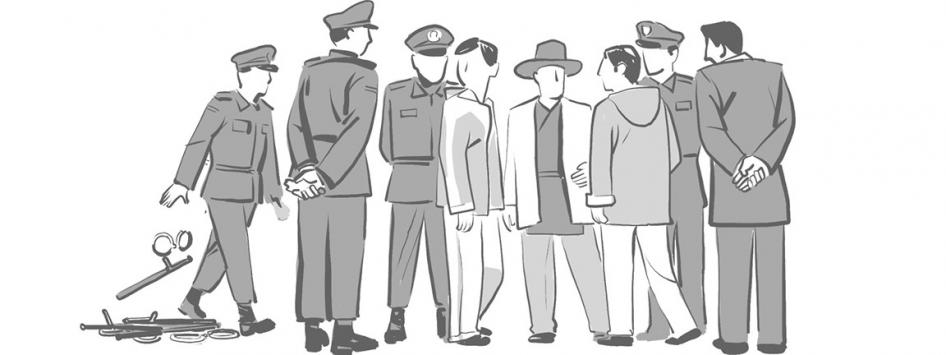Human Rights Watch has released an illustrated glossary explaining a dozen terms that have become mainstays of official propaganda on Tibet amid a wave of political suppression that has been running for years. From HRW’s introduction to the glossary:
China’s authorities place extraordinary emphasis on the importance of propaganda (xuanchuan)[1]in sustaining their rule. This phenomenon is particularly evident in Tibet, where there has been a long history of human rights violations, extreme hostility towards political rights, and heavy restrictions on the rights to freedom of expression and access to information.
[… The Propaganda Bureau’s] most visible technique is political indoctrination through the repetition of key terms and phrases in official statements and publications. Special terms or “formulations” (tifa) are created for each policy or campaign to stress whatever is seen as their most positive aspect and to make it harder for officials to avoid implementing them. Officials and the media are required to use these tifa when referring to these policies.
The terms are rarely explained in public except by reference to other obscure terms, and have meanings and implications that may be fully comprehensible only to those with access to internal documents and oral briefings within Party cells or meetings.[2] Some sound benign or even have positive aspects, but generally they represent a profoundly repressive approach to governance in Tibet. Many of the terms indicate a desire for total social and thought control: “no cracks, no shadows, no gaps left”; “eliminate unseen threats”; “nets in the sky, traps on the ground”; “every village a fortress, everyone a watchman.” A political parodist in the Orwellian tradition would be hard pressed to invent a better vocabulary of totalitarian management.
Though all of the terms carry potentially ominous overtones for anyone even contemplating political nonconformity, their precise meaning is often unclear to ordinary Tibetans and probably even to many officials. […] [Source]
In a press release, HRW’s China director Sophie Richardson further explains the glossary and the development of the propaganda vocabulary that followed widespread Tibetan unrest in 2008:
“Orwell himself would be hard pressed to invent a better vocabulary of totalitarian management,” said Sophie Richardson, China director at Human Rights Watch. “But ultimately the message of the Chinese authorities’ terms for Tibetans is clear: political nonconformity will be punished, severely.”
[…] In Tibetan areas within China, and particularly in the Tibet Autonomous Region (TAR), officials have long adhered to the “stability maintenance” policy: a range of policing and administrative systems aimed at preventing, controlling, or punishing social dissent and social disorder used across China – as one way to eradicate support for the Dalai Lama. But when a new wave of protests in support of the Dalai Lama broke out across the Tibetan plateau in spring 2008, Party leaders commissioned researchers to develop new methods to prevent future unrest.
[…] “Understanding terms like ‘social rectification’ makes clear Chinese authorities’ intentions in Tibet: that all life and daily behavior will be under surveillance, and any problematic conduct will be identified and swiftly punished,” Richardson said. [Source]
For a guide to the user-generated memes, nicknames, and neologisms created by netizens to avert and mock censorship, see CDT’s Grass-mud Horse Lexicon.
China’s central authorities strictly manage the domestic media narrative across the country, as well as the social media discussion of sensitive topics. Censors pay special attention to conflict-prone ethnic minority regions like Tibet and Xinjiang, limiting foreign journalists’ access and claiming a monopoly on coverage of violence or political protest. Since 2009, there have been 150 confirmed Tibetan protests by self-immolation, at least 125 of which were fatal.
Meanwhile, authorities have taken efforts to culturally and linguistically assimilate the Tibetan population, and have ramped up their anti-Dalai Lama diplomatic rhetoric as an overseas Chinese student group with known support from Beijing has rallied against the spiritual leader’s public speech at the University of California, San Diego. Beijing has reasserted its “right” to legitimately hold claim to Tibetan Buddhist spiritual matters as the aging Dalai Lama has repeatedly hinted that he could be the final incarnation in a centuries old political and spiritual tradition. In a further attempt to win hearts and minds in Tibetan regions of China, Beijing has in recent months situated its controversial choice for the Panchen Lama—the second highest cleric in the sect of Tibetan Buddhism overseen by the Dalai Lama—into the media spotlight. Last summer, the controversial young cleric oversaw a Kalachakra initiation ceremony in Shigatse, the first time the tantric ritual has been held in Tibet since the Dalai Lama left in 1959. More recently, in March Beijing’s Panchen Lama urged monastic Tibetans to “love the Party.”
See also CDT’s recent translation of an essay by investigative journalist Jiang Xue on the nationalization of the relatively tight restrictions on speech, security measures, and ideological constraints that have long been the norm in Tibet and Xinjiang.








